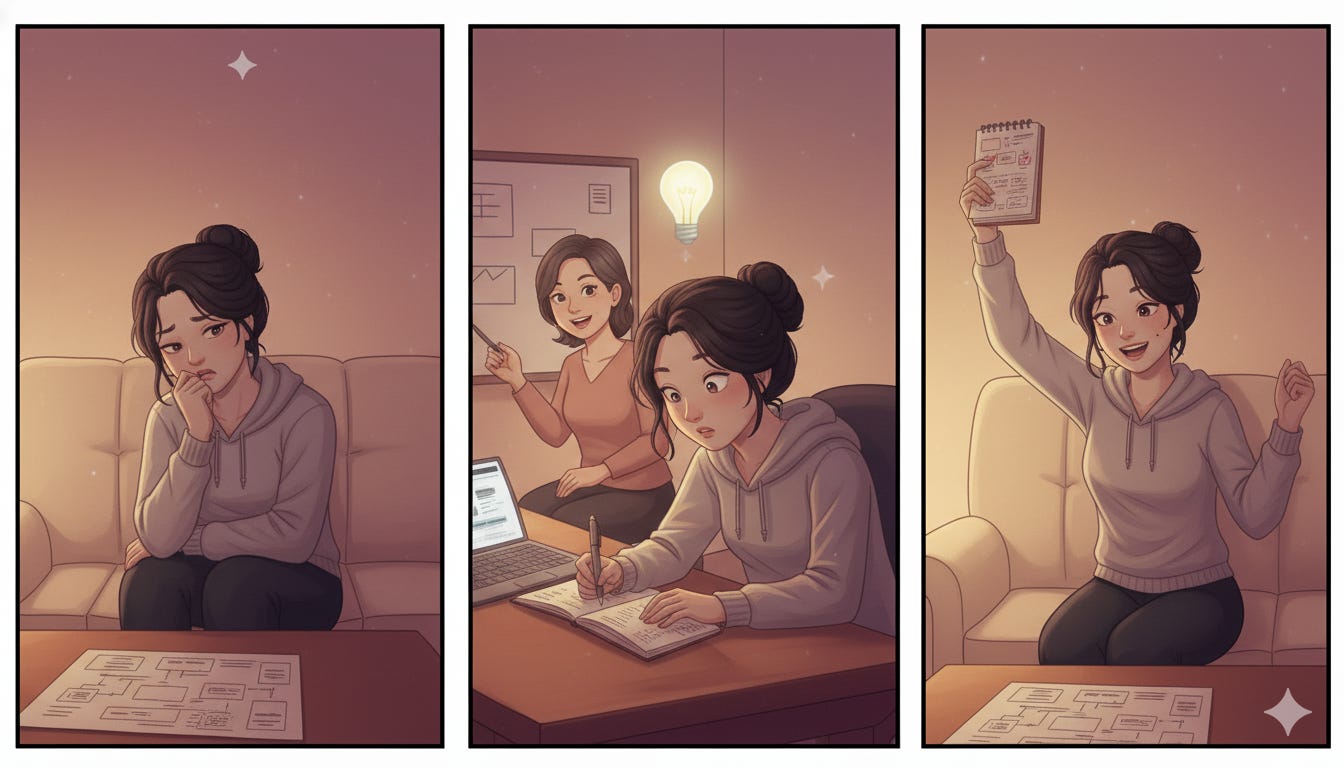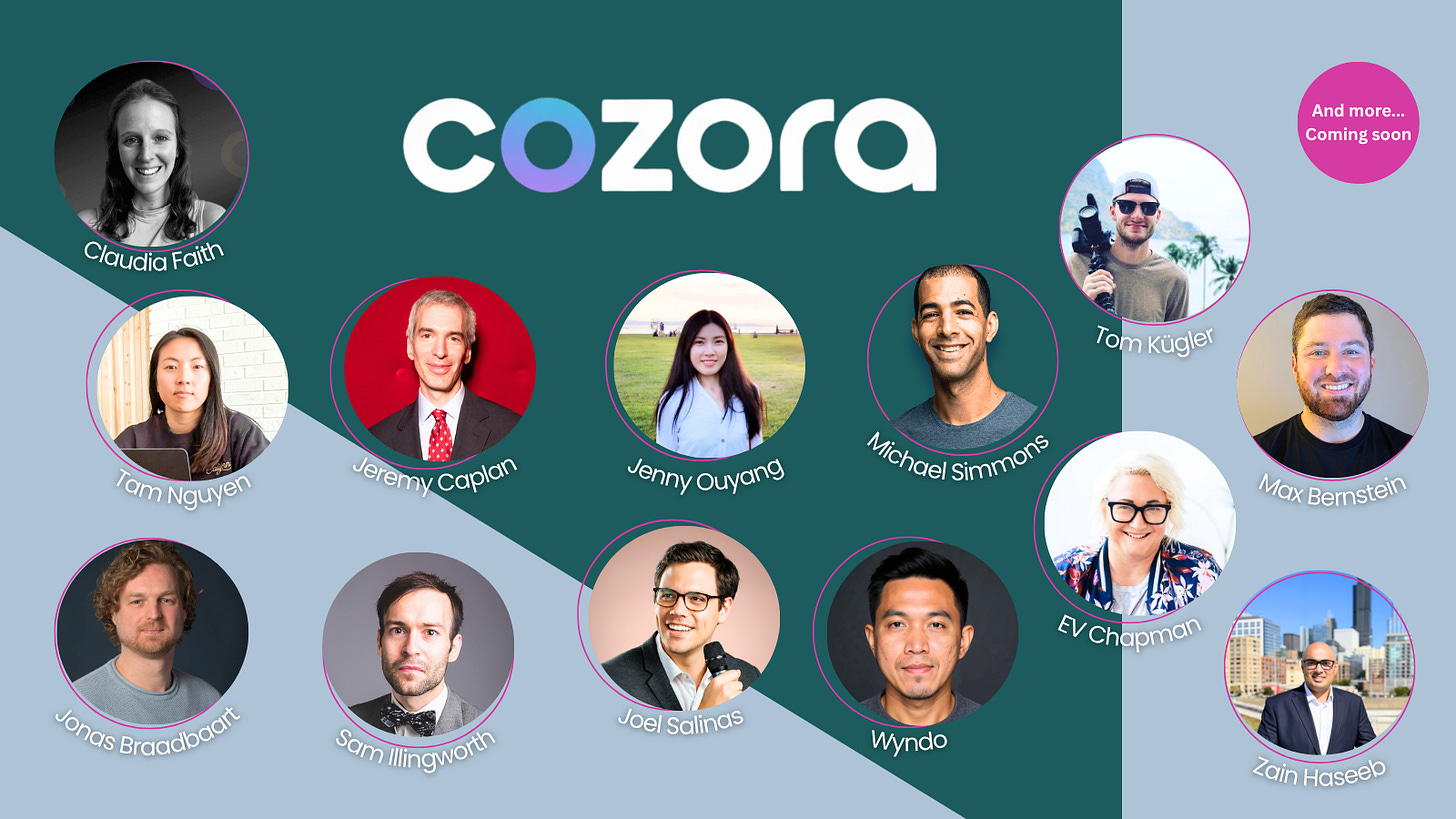Your Transcripts Contain 3 Types of Gold (You’re Throwing Away 2 of Them)
Why action items are the least valuable thing in your transcripts and what to extract instead.
I’ve always been the “systems person.” The one who sees how everything connects. Therefore the one everyone defaults to for project management.
And honestly? I hate it.
Not because I’m bad at it. I’m actually great at it. But because I don’t want to spend my entire day working to manage work. It’s ridiculous. And yet it still needs to be done.
This week, I did something interesting with our meeting transcripts. I analyzed our last 10 team calls to see what we weren’t tracking. Turns out, we averaged 3.5 new ideas per conversation. Good ideas. Ideas that could become products, content, or process improvements.
Every single one of them disappeared into the void because we had no system to capture them.
But those aren’t just ideas. They’re decisions, context, patterns, breakthrough moments… and they were all gone within 24 hours.
Research shows that within 24 hours of a conversation, we forget 50-80% of what was discussed if we don’t actively review it. By 30 days? We retain only 2-3% of the original information.[1]
Here’s what nobody tells you about transcripts: The action items are the least valuable thing in them.
Every conversation you record: client calls, team meetings, coaching sessions, strategy sessions, contains three types of value. Most people extract one, ignore the second, and don’t even know the third exists.
Let me show you what you’re missing.
The Cost of Not Capturing Intelligence
Before we get into the 3 types, let’s talk about what’s at stake.
Every week, you’re losing:
Strategic decisions and the why behind them
Patterns you can’t see because you’re not tracking them systematically
Client feedback that could inform your next product iteration
Ideas that could become content, features, or revenue
Context that would save you from re-explaining the same thing in 6 months
And if you’re anything like me, you’re spending hours each week trying to manually reconstruct what happened. Or worse, you’re just not capturing it at all.
Harvard surgeon and author of The Checklist Manifesto, Atul Gawande, proved that simple checklists reduced surgical deaths by 40% and complications by 33%. Not by making surgeons smarter, but by capturing what matters under pressure.[1]
The same principle applies to your conversations. You don’t need to be smarter. You need a better system for capturing what’s already there.
That system extracts three types of value. Let’s start with the one everyone already knows.
Type 1: Action (What Everyone Extracts)
This is the obvious one. You’re already doing it.
You read the transcript and pull out:
Tasks to complete
Commitments made
Next steps
Follow-up items
Example from a sales transcript:
“I’ll send the proposal by Friday” becomes a to-do.
“Let’s schedule a follow-up for next week” goes on the calendar.
This is transcript extraction 101. It’s table stakes. But it’s only 33% of the value.
Let’s talk about what you’re missing and why intelligence, not action, is where pros separate from beginners.
Type 2: Intelligence (What Separates Beginners from Pros)
Intelligence is what you learned from the conversation. And here’s the thing: most of it disappears within 24 hours if you don’t capture it.
David Allen, author of Getting Things Done, calls this building a “trusted system”.
Your brain stops working against you when it knows the information is captured somewhere reliable. Intelligence extraction is how you build that system for your conversations.
Intelligence includes:
Patterns you noticed
Insights that emerged
Decisions made and why
Risks identified
Context that matters later
Breakthrough moments
Questions that need answering
Emotional shifts or energy changes
This is where the real value lives.
Let me show you what intelligence extraction looks like:
I recently had my first coaching session. Afterwards, I ran the transcript through the Coaching Intelligence System prompt to see what it would extract.
Instead of just getting action items, here’s what the intelligence extraction revealed about my own conversation:
Word Frequency Analysis:
I said “enjoyment” 8 times but “automation” only 4 times
This revealed tension I didn’t consciously notice: I’m leading with technical tools when my real driver is enjoyment and meaning.
The prompt caught this pattern automatically.
Language Patterns I Didn’t Notice:
I shifted from distancing language (”you”) to ownership language (”I”) when discussing personal challenges
Unique phrasing: I said “old outdated systems” instead of “stories” - revealing how deeply systems thinking shapes how I see the world
Emotional Arc Tracked:
Starting state: Searching and uncertain
“Big question for me right now is...”
Ending state: Relieved and energized
“It felt like a breath of fresh air”
Overall trajectory: Positive shift from confusion to clarity
Session Time Breakdown:
Purpose/meaning exploration: ~20 minutes
Framework development: ~15 minutes
Personal/professional balance: ~15 minutes
Action planning: ~10 minutes
This showed me where my energy actually went vs where I thought it went.
Talk Balance:
Coach vs Client ratio: Approximately 20/80
I had space to process, several productive silence moments for reflection.
Breakthrough Moment:
The coach asked: “What’s the goal beneath the goal?”
“What is the purpose of the work that I do? How do I find meaning in my work?”
That question made me realize I’d been focused on surface goals (building automation tools) instead of the deeper purpose (helping people escape work that prevents them from finding purpose).
All of this, the patterns, the emotional shifts, the testimonial moment, the time breakdown, would’ve been lost within 24 hours if it hadn’t been extracted.
See the difference?
Action extraction gives you a to-do list. Intelligence extraction gives you a knowledge base.
Once you start capturing intelligence, you stop re-learning the same lessons. Your transcripts compound. Patterns become visible. Decisions have documentation. Your memory becomes external.
But there’s one more type most people miss entirely, and it’s the one that builds your business for you.
Type 3: Content (What Almost Nobody Considers)
Here’s what separates people who “take notes” from people who build assets: content extraction.
Your best marketing content already exists. It’s buried in your transcripts.
Content includes:
Testimonial-worthy quotes
Case study material
Social proof moments
Newsletter stories
Before/after transformations
Analogies that landed
Questions your audience actually asks
Most people don’t even think to look for this. And when they do, they’re re-listening to 60-minute recordings trying to find that one great quote.
There’s a better way.
What content extraction looks like:
Remember my coaching session? The same transcript that gave me intelligence insights also creates content gold.
Testimonial Moment Captured:
“It felt like a breath of fresh air to be able just to open up... You’re great at reflecting back things that people are saying.”
If I were the coach, this quote would be perfect for marketing. Authentic gratitude, specific praise of technique, emotional impact. She probably never would’ve remembered I said this without extraction.
Case Study Potential Identified:
The prompt flagged my session as having case study potential:
Journey from technical expert to purpose-driven consultant
Framework development for “zone of genius” discovery
This is the kind of transformation story that makes compelling marketing. It was sitting right there in the transcript.
Newsletter Story Material:
The “goal beneath the goal” moment? That’s a newsletter. The word frequency revealing I’m leading with tools instead of enjoyment? Another newsletter. The unique phrasing (”old outdated systems” instead of “stories”)? Content that shows authenticity.
All of this was extractable. None of it requires you to “create content from scratch.”
Extract All 3 Types From Your Sessions (Prompt Included)
If you’re a coach, here’s a prompt you can use right now to extract action, intelligence, and content from your coaching sessions in 60 seconds.
This is the Client Reflection Prompt - the deliverable you can share with clients after a session. It gives them:
Their goals in their own words
Action commitments with exact quotes
Breakthrough moments captured
Emotional journey tracked
Questions to explore in the next session
You’ve seen an example of what this produces and that’s exactly what my coaching session output looked like earlier in this article.
The Client Reflection Prompt
Copy this prompt, paste it into Claude or ChatGPT, then paste your session transcript:
# YOUR SESSION REFLECTION GUIDE
Use this guide to reflect on today’s coaching session and capture your insights while they’re fresh.
Paste your session transcript or notes below, and I’ll help you create a personal reflection summary.
---
## WHAT TO REFLECT ON
As you review the session, I’ll help you identify:
1. **Your Goals**: What you’re working toward
2. **Challenges**: What’s getting in the way
3. **Breakthroughs**: New insights or perspective shifts
4. **Your Commitments**: Specific actions you’ve committed to
5. **How You’re Feeling**: Your energy and emotional state
6. **Questions or Concerns**: Anything you want to explore further
---
## YOUR SESSION SUMMARY
**Date:** [Today’s date]
**Session Focus:** [Brief description]
---
### What You’re Working Toward
**Your main goals right now:**
• [Goal 1]
> “Your exact words from the session”
• [Goal 2]
> “Your exact words from the session”
---
### What You Discovered Today
**Key insights or breakthroughs:**
• [Insight description]
> “Your exact words when you had this realization”
• [Another insight]
> “Your exact words”
**What’s becoming clearer:**
• [Note progress in thinking or understanding]
> “Your exact words showing this clarity”
---
### Your Commitments
**Action steps you’ve committed to:**
1. [Specific action with timeframe]
> “Your exact commitment from the session”
2. [Specific action with timeframe]
> “Your exact commitment from the session”
> These are your words from the session — hold yourself accountable to them.
---
### What’s Still Challenging
**Current obstacles:**
• [Obstacle description]
> “Your exact words describing this challenge”
**Where you might need support:**
• [Areas to discuss in next session]
---
### How You’re Feeling
**Emotional check:**
• How you started: [emotion/energy]
> “Quote showing your starting emotional state”
• How you ended: [emotion/energy]
> “Quote showing your ending emotional state”
• Overall movement: [note positive shifts or areas needing attention]
---
### Questions for Next Time
**Topics to explore further:**
• [Open questions or unresolved areas]
**What to check in on:**
• [Progress on commitments, ongoing challenges]
---
# SESSION TRANSCRIPT
[Paste your session transcript here]
What this does for you:
Saves 20+ minutes per session on manual note-taking
Tracks client commitments with exact quotes
Creates a sharable reflection document for clients
Pro tip: Store these in Google Drive or Notion database (anonymized for privacy) with properties for Client ID/Name, Date, Key Insights, and Testimonial Quotes. After 20-30 sessions, you’ll start seeing patterns across your entire practice.
My Transformation (And Why This Matters)
Remember those 3.5 ideas per team call I mentioned at the start? The coaching session showed you what extraction looks like. Here’s what happened when I applied the same framework to our team meetings.
Not too long ago, I was using the default action items from meeting notetakers. You know the ones… bullet points of tasks, maybe a few key points if you’re lucky.
Now? I use full meeting transcripts (not the summaries) to:
Extract patterns across multiple conversations
Keep tabs on strategic discussions and decision context
Get Notion to auto-create tasks and projects
Log every new idea we can’t get to right now (but don’t want to lose)
Store client feedback and testimonials automatically
Before, this was done manually and it was TIME CONSUMING—or we just didn’t capture it at all.
Those 3.5 ideas per call? They’re not disappearing anymore. That’s exactly why having a system to extract, track, and store this data is critical. Everything is data now. The best way to make use of it is to structure it so that AI can access it in the future.
I’m no longer the default project management person spending my entire day working to manage work. AI does that for me now. I spend my time on strategy, on building, on the work that actually matters.
Here’s What Changes When You Extract All 3
Your notes become assets. Your meetings compound. Your content writes itself.
Instead of transcripts disappearing into a folder you never open again, they become:
A searchable knowledge base (intelligence)
An accountability system (action)
A content library (content)
You stop having the same conversation twice. You stop losing breakthrough moments. You stop scrambling for testimonials when you need social proof.
The conversations you’re already having start working for you long after they end.
Want the Internal Coach Prompt + Meeting Extraction Tools?
That client reflection prompt is just one part of the system. There’s also an Internal Coach Analysis Prompt that extracts deeper intelligence for your own practice development:
Coaching technique effectiveness
Client readiness assessment
Supervision flags
Next session strategy
Business intelligence (case study potential, program fit)
I’m sharing both prompts plus the meeting extraction tools I use for team calls, client calls, and strategy sessions at my Cozora session October 30th.
My session: Transcript to Gold: Turn Every Conversation Into Action, Intelligence & Content
You’ll get:
The Internal Coach Analysis Prompt
Meeting extraction prompts for team calls and client calls
How to store your intelligence so it actually compounds
Live demo: I’ll extract all 3 types from a real transcript
Q&A on building your extraction system
There’s More: You’re Not Just Getting My Session
When you join Cozora, you’re joining 13 AI practitioners’ journeys. Live expert sessions every 2 weeks from people who are actually shipping and not just teaching theory:
- (Nov 13) – Creating Your AI 2nd Brain
- (Dec 4) – Build and Ship Your First Professional Web App
- (Dec 18) – Make Your Expertise Irreplaceable in the Age of AI
- (Jan 15) – How To Clone Your Expertise With An AI Bot
- (Jan 29) – AI as a Thinking Partner in Your Knowledge System
- (Feb 12) – A Day in My Life with AI
- (Feb 26) – Slow AI: Using AI for Reflection
- (Mar 12) – The Blockbuster Content Framework
- (Mar 26) – Building Your AI Operating System
- (Apr 9) – 10 Years of Software Engineering Lessons
- (Apr 23) – Building Your Strategic AI Implementation System
- (May 7) – AI Tools for Creators Without Losing Your Voice
*Tentative titles subject to refinement
Plus: Live Q&A between sessions, co-founder matching to find technical partners, monthly showcases, and a community of builders shipping real projects.
$75/month or $720/year. Less than one dinner out for unlimited access to 13 experts who normally charge $500+/hour.
My session kicks off October 30th. The community is small now. It won’t stay that way.
P.S. You’re already recording conversations and taking notes. This is about capturing more value from work you’re already doing. The prompts, the extraction system, the community of builders - it’s all waiting. See you on the 30th.









This is the type of building I’m interested in! Heck yeah, excited for the Cozora session